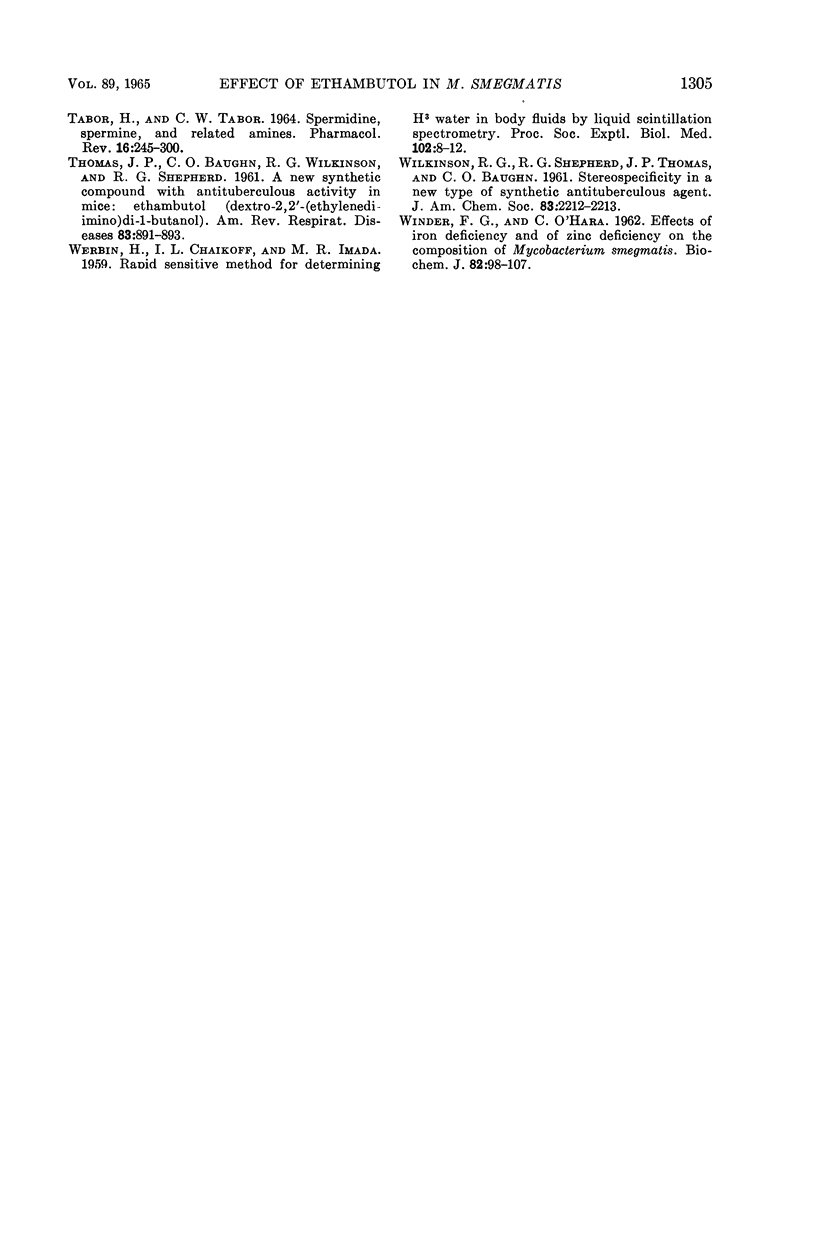Abstract
Forbes, M. (Lederle Laboratories Division, Pearl River, N.Y.), N. A. Kuck, and E. A. Peets. Effect of ethambutol on nucleic acid metabolism in Mycobacterium smegmatis and its reversal by polyamines and divalent cations. J. Bacteriol. 89:1299–1305. 1965.—Mycobacterium smegmatis, harvested from cultures inhibited by ethambutol and then suspended in drug-free medium, exhibited a prolonged lag before growth resumed. Polyamines and magnesium ions shortened this lag. Polyamines and magnesium added to the culture increased the minimal inhibitory concentration of the drug and reversed the inhibitory effect of the drug, even when added after the drug had already inhibited growth. When ethambutol was added to a culture in its exponential phase of growth, synthesis of protein and deoxyribonucleic acid (DNA), as measured by incorporation of S35 and P32, continued for 3 hr at a rate slightly less than in the control cells and then essentially ceased. Synthesis of ribonucleic acid (RNA) was depressed, but it proceeded even after protein synthesis had ceased. Even though the synthesis of RNA continued, the net RNA decreased, and inhibited cells became deficient in RNA. Polyamines and divalent cations, which reverse the inhibitory effect of the drug, have been reported to be involved in nucleic acid turnover. These considerations suggested that ethambutol may exert its inhibitory effect by interfering with a function of cellular polyamines and divalent cations in RNA metabolism.
Full text
PDF






Selected References
These references are in PubMed. This may not be the complete list of references from this article.
- COHEN S. S., LICHTENSTEIN J. Polyamines and ribosome structure. J Biol Chem. 1960 Jul;235:2112–2116. [PubMed] [Google Scholar]
- Crane R. K. Use of Charcoal to Separate Mixtures of Inorganic, Ester, and Nucleotide Phosphates. Science. 1958 Feb 7;127(3293):285–286. doi: 10.1126/science.127.3293.285. [DOI] [PubMed] [Google Scholar]
- DAVIDSON J. D., FEIGELSON P. Practical aspects of internal-sample liquid-scintillation counting. Int J Appl Radiat Isot. 1957 Apr;2(1):1–18. doi: 10.1016/0020-708x(57)90021-2. [DOI] [PubMed] [Google Scholar]
- DOERFLER W., ZILLIG W., FUCHS E., ALBERS M. [Studies on the biosyhthesis of proteins. V. The function of nucleic acids in the incorporation of amino acids into proteins in a cell free system in Esherichia coli]. Hoppe Seylers Z Physiol Chem. 1962 Dec 15;330:96–123. doi: 10.1515/bchm2.1962.330.1.96. [DOI] [PubMed] [Google Scholar]
- FORBES M., KUCK N. A., PEETS E. A. Mode of action of ethambutol. J Bacteriol. 1962 Nov;84:1099–1103. doi: 10.1128/jb.84.5.1099-1103.1962. [DOI] [PMC free article] [PubMed] [Google Scholar]
- FOX C. F., WEISS S. B. ENZYMATIC SYNTHESIS OF RIBONUCLEIC ACID. II. PROPERTIES OF THE DEOXYRIBONUCLEIC ACID-PRIMED REACTION WITH MICROCOCCUS LYSODEIKTICUS RIBONUCLEIC ACID POLYMERASE. J Biol Chem. 1964 Jan;239:175–185. [PubMed] [Google Scholar]
- GALE G. R., MCLAIN H. H. EFFECT OF ETHAMBUTOL ON CYTOLOGY OF MYCOBACTERIUM SMEGMATIS. J Bacteriol. 1963 Oct;86:749–756. doi: 10.1128/jb.86.4.749-756.1963. [DOI] [PMC free article] [PubMed] [Google Scholar]
- HAROLD F. M. Accumulation of inorganic polyphosphate in mutants of Neurospora crassa. Biochim Biophys Acta. 1960 Dec 4;45:172–188. doi: 10.1016/0006-3002(60)91438-4. [DOI] [PubMed] [Google Scholar]
- HERBST E. J., DOCTOR B. P. Inhibition of ribonucleic acid degradation in bacteria by spermine. J Biol Chem. 1959 Jun;234(6):1497–1500. [PubMed] [Google Scholar]
- KRAKOW J. S. RIBONUCLEIC ACID POLYMERASE OF AZOTOBACTER VINELANDII. III. EFFECT OF POLYAMINES. Biochim Biophys Acta. 1963 Aug 20;72:566–571. [PubMed] [Google Scholar]
- KUCK N. A., PEETS E. A., FORBES M. Mode of action of ethambutol on Mycobacterium tuberculosis, strain H37R V. Am Rev Respir Dis. 1963 Jun;87:905–906. doi: 10.1164/arrd.1963.87.6.905. [DOI] [PubMed] [Google Scholar]
- LOWRY O. H., ROSEBROUGH N. J., FARR A. L., RANDALL R. J. Protein measurement with the Folin phenol reagent. J Biol Chem. 1951 Nov;193(1):265–275. [PubMed] [Google Scholar]
- Martin R. G., Ames B. N. THE EFFECT OF POLYAMINES AND OF POLY U SIZE ON PHENYLALANINE INCORPORATION. Proc Natl Acad Sci U S A. 1962 Dec;48(12):2171–2178. doi: 10.1073/pnas.48.12.2171. [DOI] [PMC free article] [PubMed] [Google Scholar]
- PLACE V. A., THOMAS J. P. Clinical pharmacology of ethambutol. Am Rev Respir Dis. 1963 Jun;87:901–904. doi: 10.1164/arrd.1963.87.6.901. [DOI] [PubMed] [Google Scholar]
- ROBSON J. M., SULLIVAN F. M. Antituberculosis drugs. Pharmacol Rev. 1963 Jun;15:169–223. [PubMed] [Google Scholar]
- TABOR H., TABOR C. W. SPERMIDINE, SPERMINE, AND RELATED AMINES. Pharmacol Rev. 1964 Sep;16:245–300. [PubMed] [Google Scholar]
- THOMAS J. P., BAUGHN C. O., WILKINSON R. G., SHEPHERD R. G. A new synthetic compound with antituberculous activity in mice: ethambutol (dextro-2,2'-(ethylenediimino)-di-l-butanol). Am Rev Respir Dis. 1961 Jun;83:891–893. doi: 10.1164/arrd.1961.83.6.891. [DOI] [PubMed] [Google Scholar]
- WERBIN H., CHAIKOFF I. L., IMADA M. R. Rapid sensitive method for determining H3-water in body fluids by liquid scintillation spectrometry. Proc Soc Exp Biol Med. 1959 Oct;102:8–12. doi: 10.3181/00379727-102-25125. [DOI] [PubMed] [Google Scholar]
- WINDER F. G., O'HARA C. Effects of iron deficiency and of zinc deficiency on the composition of Mycobacterium smegmatis. Biochem J. 1962 Jan;82:98–108. doi: 10.1042/bj0820098. [DOI] [PMC free article] [PubMed] [Google Scholar]


